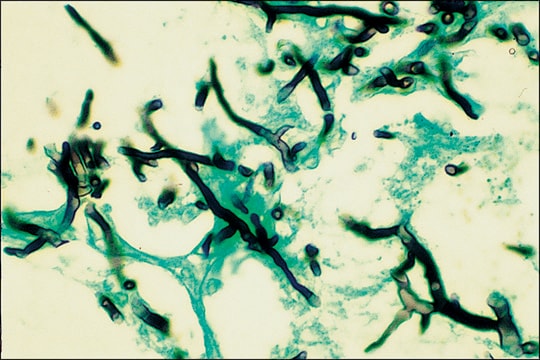05495
Silver proteinate
~8% Ag basis
Synonym(s):
Albumose silver, Protargol, Silver protein, strong
Sign Into View Organizational & Contract Pricing
All Photos(1)
About This Item
Recommended Products
concentration
~8% Ag
pH
8.0-9.5 (10 mg/mL in H2O)
Looking for similar products? Visit Product Comparison Guide
Application
Silver proteinate (Protargol) is used as a component of the Periodic Acid-ThioSemiCarbazide-Silver Proteinate (PA-TSC-SP) staining protocol for ultrastructural detection of carbohydrates such as glycogen, and proteoglycans.
Other Notes
Protargol silver impregnation and neuronal selectivity - light and electron microscopic observations
Storage Class Code
6.1C - Combustible acute toxic Cat.3 / toxic compounds or compounds which causing chronic effects
WGK
WGK 3
Flash Point(F)
Not applicable
Flash Point(C)
Not applicable
Personal Protective Equipment
dust mask type N95 (US), Eyeshields, Gloves
Choose from one of the most recent versions:
Already Own This Product?
Find documentation for the products that you have recently purchased in the Document Library.
Xiaozhong Hu
European journal of protistology, 44(2), 115-129 (2007-11-21)
The morphology and morphogenesis of Diophrys japonica spec. nov., isolated from the Mie Port, Nagasaki, Japan, were investigated from life and following impregnation with protargol. The new species is recognized by the following characters: Body elliptical in outline and slightly
Kuidong Xu et al.
European journal of protistology, 46(4), 263-270 (2010-09-17)
Methodological impediments have long been the main problem in estimating the ecological role of marine benthic ciliates. Percoll density centrifugation is currently the most efficient technique for extracting ciliates from fine-grained sediments, while the high cost and low density of
Hongbo Pan et al.
European journal of protistology, 47(3), 197-207 (2011-05-14)
The morphology and infraciliature of four marine cyrtophorid ciliates isolated from Qingdao, China, were investigated. Based on the present work and on previous data, improved diagnoses for three rarely known species are provided: (1) Mirodysteria decora; small-sized marine Mirodysteria about
J Nanchahal et al.
The British journal of dermatology, 113(4), 397-404 (1985-10-01)
Dermo-epidermal separation in dystrophic epidermolysis bullosa (DEB) is thought to results from an abnormality of anchoring fibrils which, in normal skin, are stained selectively by the periodic acid-thiosemicarbazide-silver proteinate technique. This method was applied to non-lesional skin from four patients
Xinpeng Fan et al.
European journal of protistology, 47(3), 186-196 (2011-05-17)
Three marine scuticociliates, Falcicyclidium fangi nov. gen., nov. spec., Falcicyclidium atractodes nov. spec., and Cristigera media Kahl, 1928 were investigated using live observation and silver impregnation methods. The genus Falcicyclidium is distinguished by the combination of: (i) dorsoventrally flattened body
Our team of scientists has experience in all areas of research including Life Science, Material Science, Chemical Synthesis, Chromatography, Analytical and many others.
Contact Technical Service







